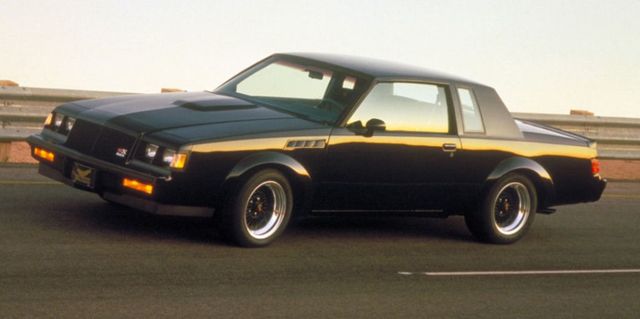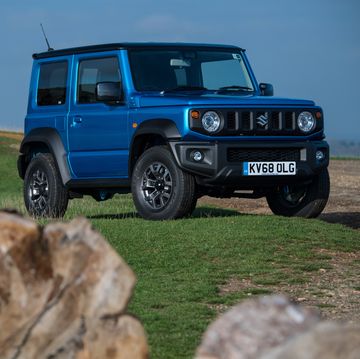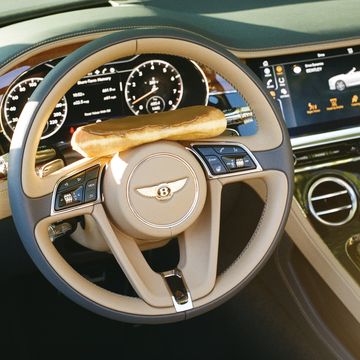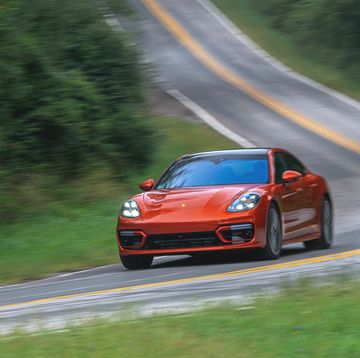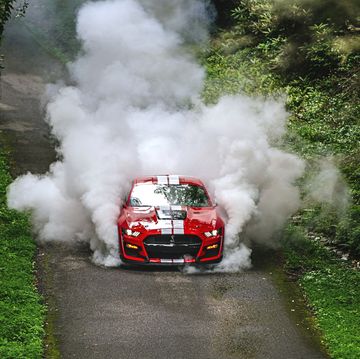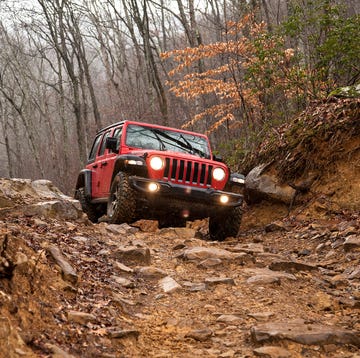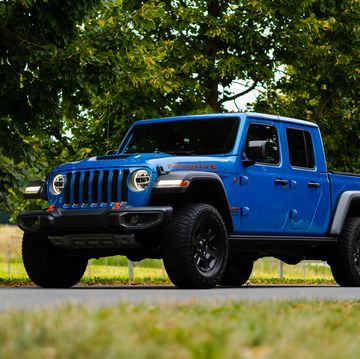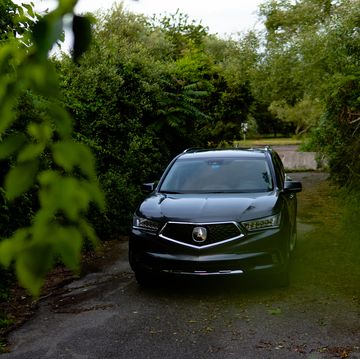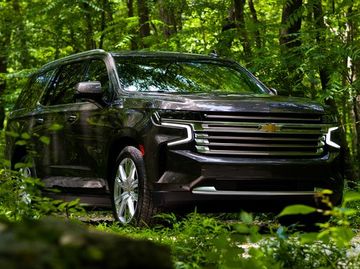This article originally appeared in the June 1987 issue of Road & Track.
It's this easy: Find a lonely straight road, preferably a drag strip. Make certain the engine of the Buick Grand National GNX is up to temperature. Hold your left foot lightly on the brake while your right foot presses down gently on the accelerator. Engine revs will climb as you take up the slack in the torque converter. The car will try to move forward. You might have to press a bit harder on the brake to keep the GN stationary, but be subtle, almost gentle.
Then slam the gas pedal down as you lift off the brake. The back of the Buick will slew a bit as the fat tires scratch for traction, but keep your foot down because the Goodyears will quickly grab and send you rushing down the road. Less than 6.0 seconds after you mashed the throttle, you will be going 60 mph. If you're on a drag strip and keep your foot down, come 14.0 sec you'll have covered the quarter mile and be traveling around 105 mph. If you still haven't had enough, keep your right foot working, and when you feel the engine rev limiter cut in, you'll be doing 124 mph. And that was a gentle run.
Not bad for a 3500-lb lame duck.
Come this autumn, the current Buick Regal will be history. In production since 1978, it's among the few front-engine, rear-drive models still sold by the corporation. And to some minds, its rear drive makes it a dinosaur. Just don't tell Mercedes-Benz, BMW or Corvette engineers that rear drive is not the future.
When the Regal goes away, so will the Grand National. Too bad. There may be a great deal in the normal versions of this Buick that seems old-fashioned, but with 245 bhp and 355 lb-ft of torque from its turbocharged, intercooled V-6, others find the GN to be just plain fun. Some people at Buick are also disappointed to see the GN go away. Not only is it a great image machine, but also it can put away the Corvette to both 60 mph and through the quarter mile. So long, bragging rights.
Buick is not about to let the GN go quietly, however, and will send the Regal out the door with one last ground-pounding model, the Grand National GNX. This isn't just a Buick project, but the result of a plan hatched at the 1985 Indy 500 between Buick and McLaren Engines. The automaker sent the engine builders a standard Grand National V-6 they could develop with possible production in mind. Now that the program has been approved by GM, American Sunroof Corp. McLaren's parent company, will receive Grand Nationals ordered by Buick dealers and convert them to GNX spec.
There will only be 500 Grand National GNXs built, with a sticker of $26,000-$28,000. Displacement remains the same, at 3.8 liters. To use a new automotive verb, the car has been "chipped," which means the ROM chip in the computer has been modified, in this instance so the fuel injection is less rich at full throttle. Turbo boost is a bit higher, 16.0 psi in 1st and 2nd gears versus 15.0, with a maximum of 14.0 in 3rd and 10.0 (unchanged) in 4th. Porting in the heads has been cleaned up for better flow.
There's a different Garrett AiResearch turbo with a larger housing, dynamic oil seals for less drag and a ceramic turbine, which is lighter. The shape and number of fins in the intercooler have been changed for greater fin density and effectiveness. There already is an engine oil cooler in the Grand Nationals, and the GNX adds a cooler for transmission fluid, though that's the only change to the Turbo Hydramatic 200 4R.
Off the dyno the GNX engine is up 55 bhp from the standard Grand National's rating to 300 at 4400, while torque climbs from 355 to 420 at 2400 rpm.
Buick had already reached the limits of the Regal's suspension with the Grand National, so the GNX is beefed up still more. The rear suspension's production lower control arms stay, joined now by a Panhard rod and a very substantial longitudinal torque bar. Attached to a crossmember forward of the differential, the bar looks like an elongated vee laid on its side with four vertical braces. The open end of the torque bar is firmly bolted to the top and bottom of the differential.
Buick said one major reason for the 124-mph limit on the Grand National is the lack of V-rated P215/65R-15 tires. The GNX gets the proper rubber, Goodyear Gatorbacks measuring P245/50VR-16s for the front wheels and P255/50VR-15s at the back. To fit inside the Regal wheel wells, the housings had to be enlarged and are trimmed on the outside with wheel lip moldings. Buick keeps the rev limiter set for 124 mph, however, figuring that's a reasonable limit. . . and probably remembering this is still a Regal chassis. Incidentally, rumor has it this top speed limit does not apply to the Grand Nationals bought by the FBI.
There are a few other changes that mark a GNX. The stock instruments are replaced with white-on-black dials from Stewart Warner, perhaps to remind the driver of the no-nonsense nature of the car. To help exhaust some of the heat build-up from the 300 bhp V-6, there is a row of vents on each fender. Older buyers might want to call them portholes. On the grille and trunk lid are GNX badges. As with the standard Grand Nationals, all GNXs are, like early Model Ts, available in any color, as long as it's black.
Say you manage to snag one of the GNXs for your own. What could you do with it? Some might consider locking it away because in this era of too many same-same cars, there are precious few that will be the serious special interest cars of the future. This is one of them.
You could go looking for Corvettes to embarrass.
Officially, Buick claims a 0-60 mph time of 5.4 sec for the GNX versus their Grand National number of 6.9. Through the quarter mile, the GNX clocks 13.4 sec to 104.0 mph against 15.7 at 97.5. Remember, however, that these are a manufacturer's figures and are conservative to cover worst-case scenarios with customers. For example, when R&T tested a Grand National, we got to 60 mph in 6.0 sec and through the quarter mile in 14.7 sec at 94.0 mph.
Our testing of the GNX has thus far been a matter of informal timings at GM 's Mesa proving ground using the original GNX prototype, which had been well used. Nonetheless, with just a little tire warming, 0-60s in the 5.6-5.7 range came easily and repeatedly. The best of our quarter miles was 13.8 with speedometer readings in the 104-mph range. Given a fresh car and the right conditions, those figures could be trimmed more.
Most interesting, perhaps, is the ease with which the GNX will run those times. There may have been a few supercars of the late Sixties and early Seventies that were a bit quicker, but they were a great deal more work. Sometimes it meant rowing your way through manual shifters as beefy as crowbars or contending with suspension that couldn't handle the available torque and kept trying to run into the next lane. The supercars of 15-20 years ago used 7.0 normally aspirated liters or more to do what the Buick does with 3.8, a turbo and an intercooler. In fairness, however, those now-elderly machines, with names like Hemi Charger 500s, Six-Pack Super Bee, 4-4-2, The Judge and Buick's own GS 455 Stage I, had price tags more in the $4500-$5000 range.
Six-second 0-60s are so easy in the GNX I suspect my 16-year-old daughter, her new driver's license in hand, could be doing them with 10 minutes of training. And wouldn't she love to try?
